Measuring Mesoamerica by the Cubit
by V. Garth Norman
Materials, concepts, maps or conclusions presented at our forums or appearing on this website or
emailed to BMAF members and guests is the sole responsibility of the contribiuting author(s) and does
not necessarily imply that members of the Board of Directors or members of BMAF agree with all or
any part of the subject matter and is not sponsored in any way by the Church of Jesus Christ of Latter-day Saints
| Editor's note: In a Times and Seasons editorial dated October 1, 1842 titled "Zarahemla," the Prophet Joseph Smith identified the region of ancient Maya ruins located in southeastern Mexico as the land where the city of Zarahemla was located. While Joseph's name is not attached, the editor's hand sign is, and he had announced his full personal responsibility for the contents of the paper during his editorship in 1842. Soon after the "Zarahemla" editorial he announced he was no longer responsible for the contents of the paper, and was turning that responsibility over to John Taylor. The land where the Book of Mormon history took place, is where archaeology will ultimately sustain the authenticity of Mormon's record. The evidence must start with proof of Middle Eastern origins migrations in the time periods required by the Book of Mormon. Garth Norman's cubit measures discovery goes a long way toward achieving that goal. |
Every school child has been taught for as long as we can remember that ancient America was populated by migrants from Asia who traveled across the Bering Strait land bridge. Paleolithic cultures across the American landscape and DNA tests confirm this early connection. In addition, Thor Heyerdahl ‘s balsa wood raft Kon Tiki’s expedition in 1947 demonstrated the oceans could be crossed in primitive sailing craft. I became curious in my university years to know if Heyerdahl’s expeditions had anything to do with ancient Native Americans coming from across the oceans. What affected the rise of the great civilizations in Middle America and the Andes of South America in the second and first millennia B.C.?
A fiery debate grew in the 1800’s from a popular diffusion theory which dominated research thinking at that time. It was driven by the notion that ancient high cultural civilizations and monumental ruins, foreign to American Indian tribal societies, must have been built by people who migrated from Old World civilizations. A small number of Isolationists challenged this theory spurring the “psychic unity of man” hypothesis to explain similar intellectual and material culture development by independent nations, as opposed to migration influence.
As this archaeology isolationist discipline grew, cultural remains were studied more intensively in their own contexts to reconstruct the past without looking for Old World influences. This widened the gulf between Diffusionists and Isolationists. Regrettably, some traditional anthropologists today feel it is an insult to Mayan Indians to suggest the high civilization of their ancestors resulted from transoceanic influences, implying the Maya could not have developed their sophisticated culture on their own.
Conversely, Cyrus Gordon, a leading scholar on Semitic research became impressed in the 1960’s with trans-oceanic contacts. He felt the rise of civilization in Middle America occurred naturally from north-south overland contact as well as from ancient migrations across both seas. His book Before Columbus: Links Between the Old World and Ancient America published in 1971, became a best seller overnight. But academic censorship put up roadblocks. Some of his colleagues felt a scholar of his reputation should not engage in such a controversial subject.
Other leading American anthropologists including Gordon Ekholm, author of Is American Indian Culture Asiatic? (1950), Stephen Jett’s Trans Oceanic Contacts (1978), Michael Coe, author of Archaeological Linkages with North and South America at La Victoria, Guatemala (1960) and David Kelly, Professor of Archaeology, University of Calgary have stepped forward in favor of trans-oceanic contacts research. I remember well an electrifying moment in 1976, in Washington D.C. at a Dumbarton Oaks Conference (Harvard Research Library and Collections) on “Mesoamerican Worldview” where archaeo-astronomer John Carlson presented a Chinese geomancy model to analyze a Mesoamerican temple center design. He cautiously paused two or three times in his inventory of parallels to clarify that his comparisons were in no way intended to imply cultural contact! However, as soon as Carlson finished, Michael Coe stood up and gestured to Dave Kelly to defer to him for the first comment, due to his long research interest in trans-oceanic contacts. Coe then stated: “I am convinced from Carlson’s paper that we have got to give serious attention to trans-oceanic contacts research.” Gordon Ekholm, sitting behind me, gave a sigh of relief saying, “Phew—it’s about time!”
Paralleling these investigations, Ekholm did sustained research through the 1950’s and 60’s in possible trans-oceanic contacts. One parallel he pointed out at Palenque still intrigues us. Palenque emerged around 600 A.D. precisely when Islam was on the move by land and sea as a new world power, spreading its religion and architecture far and wide. Palenque, near the Usumacinta river sea port, is the only Classic Maya ruin that has the distinctive keyhole shaped arches of Islam and a typical Islam prayer tower “minoret” rising four stories from the corner of a temple compound. These and other evidences for ancient cultural contacts across the oceans remain in relative obscurity because of the grip of the Isolationists. The Americanist establishment has deemed these evidences, no matter how convincing, as unwelcome and “accidental parallels” in the rise of ancient American civilizations.
Carpenter-Archaeologist measures Izapa Temple Center; finds Old World Measures
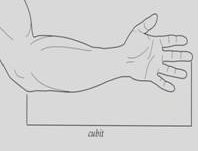
(Picture of cubit arm – Skinner 2006:31)
During an eleven year study of the Izapa Project (1965-1976), Southern Mexico with the BYU-New World Archaeological Foundation (NWAF), I produced accurate drawings of all the Izapa monuments. In my youth I was trained to be a finish carpenter by my father. Precision measuring became second nature to me. On my numerous trips to Izapa during the NWAF project I started measuring glyphs and figures as well as distances between sky and base panels on the low relief carvings. During my Izapa sculpture study with NWAF, I measured comparable figures on different monuments as well as distances between sky and base panels and discovered consistent dimensions. This implied the use of a standard measure. After completing the NWAF Izapa sculpture project, I began, in the early 1980’s, a serious study to find standard measures on all Izapa sculptures. In the final analysis I decoded two Izapa standards -- 49.5 cm. and 52.5 cm. codo (forearm cubit)--confirmed within geometric design formats. During the Izapa investigation I found that the prevailing standard measures were used in divisions of half, quarter, eighth, sixteenth, etc.
In later comparative library study I was startled to find that these two standards were identical to the Royal Babylonian and Royal Egyptian cubits! This raised significant questions: 1) was this a local system or did it occur throughout Mesoamerica, 2) when did these standard measures begin and end, 3) were they imported from the Middle East? These questions expanded my research beyond Izapa to museums and other archaeological sites across Mesoamerica. My measuring tape became my constant companion in all of my travels. Museum Directors were always helpful in allowing me to measure and photograph monuments for comparative study.
 I first went to the world renowned National Museum of Anthropology and History in Mexico City—the center for studying antiquities of the New World. I found consistent use of both the 49.5 cm. and 52.5 cm. measurements on numerous monuments spanning over 2,000 years of Mesoamerican civilization from the earliest Olmec to Aztec. My favorite, the clincher, was a life sized stone statue from Juchitan, Oaxaca with crossed stiff arms. Both forearms from elbow to extended fingertips measure exactly 49.5 cm., documenting the Babylonian cubit.
I first went to the world renowned National Museum of Anthropology and History in Mexico City—the center for studying antiquities of the New World. I found consistent use of both the 49.5 cm. and 52.5 cm. measurements on numerous monuments spanning over 2,000 years of Mesoamerican civilization from the earliest Olmec to Aztec. My favorite, the clincher, was a life sized stone statue from Juchitan, Oaxaca with crossed stiff arms. Both forearms from elbow to extended fingertips measure exactly 49.5 cm., documenting the Babylonian cubit.
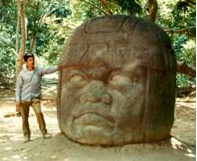 The Gulf Coast heartland of the Olmec civilization dates to Jaradite times. In this region I hoped to be able to identify distinctive standard measures from that early civilization. Numerous measures of the Olmec stone sculptures confirmed the use of both the Babylonian and Egyptian cubits. My main measurements were made in the collections at the beautiful Veracruz State Museum at Jalapa and the La Venta Park Museum at Viahermosa, Tabasco. The Olmec civilization sprang up here fully developed without any recognized evolutionary antecedents anywhere in the Americas. Sculptures with heavily bearded figures were labeled “bearded foreigners” by Yale’s art historian Titiana Proskourikoff, without any hint as to where they may have come from.
The Gulf Coast heartland of the Olmec civilization dates to Jaradite times. In this region I hoped to be able to identify distinctive standard measures from that early civilization. Numerous measures of the Olmec stone sculptures confirmed the use of both the Babylonian and Egyptian cubits. My main measurements were made in the collections at the beautiful Veracruz State Museum at Jalapa and the La Venta Park Museum at Viahermosa, Tabasco. The Olmec civilization sprang up here fully developed without any recognized evolutionary antecedents anywhere in the Americas. Sculptures with heavily bearded figures were labeled “bearded foreigners” by Yale’s art historian Titiana Proskourikoff, without any hint as to where they may have come from.
The Middle Eastern likeness and my measure results make it all too obvious that they came across the Atlantic from the Mediterranean world. Why hasn’t this been headline news? This discovery hit the “Iron Curtain” of the American evolutionary Isolationist scientific mindset.
 Southeast of La Venta at Palenque I measured carved arms and feet of live sized stucco figures and hieroglyphic panels. The forearms of figures were exactly 49.5 cm.--the Babylonian cubit. Southwest of Palenque, the Chiapas Regional Museum at Tuxtla Gutierrez houses many sculptures and artifacts of Chiapas. Many measures continued to confirm the two standard measures. At the Guatemala National Museum in Guatemala City, I found the same measures on numerous Mayan sculptures. At the archaeological site of Quirigua in Guatemala near the Caribbean, double hieroglyphic panels like those at Palenque (see photo at left) predictably had the same 49.5 cm. cubit wide!
Southeast of La Venta at Palenque I measured carved arms and feet of live sized stucco figures and hieroglyphic panels. The forearms of figures were exactly 49.5 cm.--the Babylonian cubit. Southwest of Palenque, the Chiapas Regional Museum at Tuxtla Gutierrez houses many sculptures and artifacts of Chiapas. Many measures continued to confirm the two standard measures. At the Guatemala National Museum in Guatemala City, I found the same measures on numerous Mayan sculptures. At the archaeological site of Quirigua in Guatemala near the Caribbean, double hieroglyphic panels like those at Palenque (see photo at left) predictably had the same 49.5 cm. cubit wide!
In 1985, I was invited to participate in the Palenque Roundtable Symposium to share my pioneering research of Izapa’s influence on later Maya sculpture. My paper revealed for the first time measured geometric formats in Olmec, Izapan, Mayan and Aztec sculpture. In the appendix at the end of my paper I listed Egyptian and Assyrian comparisons.
Middle Eastern Standard Measures
My pioneering study of measure in Mesoamerican sculpture interestingly preceded any such study of Middle Eastern sculpture. Finding the Middle Eastern cubits implied the same measure tradition would be found in early Middle Eastern sculpture preceding the Olmec sculpture before 1,000 B.C. If so, this would be good evidence for a possible Jaredite migration origin. I had to investigate.
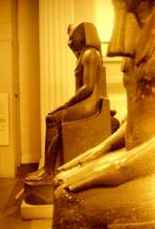 In 1990, Art Historian Lance Harding accompanied me to Europe where we measured the huge collections of Middle Eastern sculpture in the British Museum in London, and the Louvre in Paris. Our excitement and anticipation was rewarded as we went from sculpture to sculpture finding arms, feet and panel measures based on the same tradition and standards I had previously found in Mesoamerica. We found the same measure division system of Mesoamerica in the Middle Eastern sculpture: divisions of half, quarter, eighth, sixteenth, etc. well documented on Egyptian measuring rods. Except for obvious style differences, the measure study of Old World sculptures was an unbroken continuum through time and space. Many Egyptian, Assyrian, Syrian, and Sumerian sculptures had indeed been created with measuring rods of the Babylonian and Egyptian cubits. (1)
In 1990, Art Historian Lance Harding accompanied me to Europe where we measured the huge collections of Middle Eastern sculpture in the British Museum in London, and the Louvre in Paris. Our excitement and anticipation was rewarded as we went from sculpture to sculpture finding arms, feet and panel measures based on the same tradition and standards I had previously found in Mesoamerica. We found the same measure division system of Mesoamerica in the Middle Eastern sculpture: divisions of half, quarter, eighth, sixteenth, etc. well documented on Egyptian measuring rods. Except for obvious style differences, the measure study of Old World sculptures was an unbroken continuum through time and space. Many Egyptian, Assyrian, Syrian, and Sumerian sculptures had indeed been created with measuring rods of the Babylonian and Egyptian cubits. (1)
East Asian Measures
My wife, Cheryl, and I traveled to the Orient-- to Japan and Taiwan in 1989, and to mainland China (Beijing, Xiong and Shanghai) in 1996. I carried my trusty measuring tape with me. Visiting museums I was able to measure some artworks and found some tempting matches to motivate follow up study. These trips were music and mission tours with my wife, not archaeological research trips, so my measuring opportunity was limited.
An opportunity to expand measuring Asian artifacts came during a Kirtland, Ohio LDS restoration project in June of 2000, Director T. Michael Smith, along with Lance Harding and I were able to visit the famous Cleveland Museum of Art with impressive world wide collections including a large collection from Asia. I was delighted to find that several of the Asian sculptures had increments of the Babylonian or Egyptian cubits. The prize find was a beautifully sculptured Chinese stone box with three dimensional measures based on prime increments of the Egyptian cubit. Ancient trade between the Middle East and China is a known fact. The use of the Egyptian cubit reveals a cultural influence from ancient Egypt that has not been known before. I treasured this discovery because it showed another link of ancient world travel from the Middle East to far distant corners of the world. This spurred my curiosity to research into more of the art and sculpture from that vast continent when I returned home. Positive results are still emerging from these searches.
In 2006, my wife and I traveled to the Middle East to measure the art and architecture in museums as well as archaeological sites. We visited the National Museum and the Pyramids at Giza in Cairo, Egypt. The tombstone inside the main pyramid at Giza, not surprisingly, was measured to increments of the Egyptian Cubit. From Cairo we flew to see the breathtaking Temple of Luxor, Valley of the Kings and Karnak on the Nile where I measured the art and architecture and found, predictably, increments of the Egyptian Cubit.
From Egypt we flew across Saudi Arabia to Oman, on the shores of the Indian Ocean (Arabian Sea) where we walked through an ancient fortification. Excited with anticipation, I stretched my measuring tape on stones as we walked through the ruins of an ancient citadel (ca. 400 B.C.). I found the Babylonian Cubit as well as Egyptian Cubit were used to cut stone work in a small shrine (see figure at right).
The climax of our trip was a visit to Israel. We were among very few tourists who risked a trip there so soon after the Lebanese War of July, 2006. Our young Muslim guide took us to the new world-class National Museum of Israel. The antiquity exhibits were organized according to places and time periods with enlightening English explanations. The opportunity to measure was limited, but I was able to measure a few artifacts with positive results.
Search for Solomon’s Temple
During our 2006 visit to Israel, I initiated a search for Solomon’s Temple site based on astronomical data. In April, 2008, I organized a research trip to Israel, this time with three colleagues, Astronomer John Pratt, Art Historian Lance Harding, and Guide Jason Jones. We collaborated with the Director of the Springville Museum of Art, Vern Swanson, to assist with his research project in search of an ancient altar site on the Mount of Olives. In return he assisted with our flight expenses generously donated by Lyle Mortimer, Cedar Fort Publishers, Springville, Utah.
Research is restricted on the Jerusalem Temple Mount but I sat down and measured a single pavement stone. It measured exactly 49.5 cm. square—the Babylonian cubit (see photo in research report www.ancientamerica.org). We visited various museums and some archaeological sites as well as catacombs in the antiquities of Israel where I had some success with my measuring project. (http://www.meridianmagazine.com/sci_rel/080815temple.html).
Back home I analyzed the Jerusalem Temple Mount measurements and geometric design and compared the results with my prior study of the Izapa Temple Center design plan. The 49.5 cm. Babylonian cubit measured the geometric design plan in similar ways for both temple centers . The geometric design of the Izapa Temple Center is based on the same design system as that of the upper platform of the Jerusalem Temple Mount. Other intricate parallels are woven into these two ancient temple centers revealing far more than a “cubit connection.” The time period of Izapa (400 B.C.Late PreClassic) falls into the early Nephite culture timeframe. Our search and recording continues. Utah Valley University Film Production Professor Dennis Lisonbee traveled with me to Mexico in 2009 to film Izapa’s monuments and measurements to be used for media production resource material.
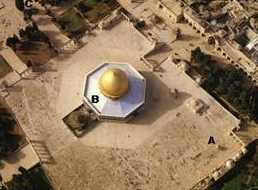 |
.png) |
| Jerusalem Temple Mount |
Izapa Temple Center Diarama Constructed by V Garth Norman for BYU-NWAF |
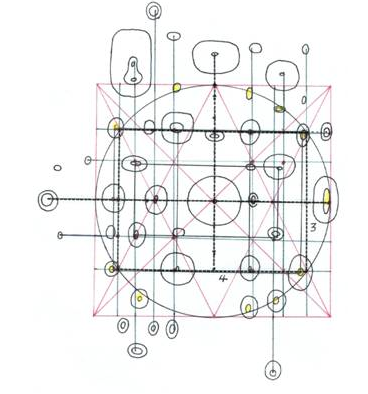 |
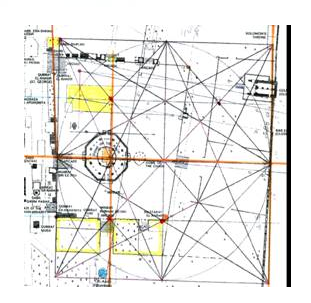 |
| Jerusalem Temple Mount and | Izapa Temple Center: Geometric analysis © V. Garth Norman 2008 |
Atlantic Conference – Halifax, Nova Scotia – August, 2008
We can be sure our efforts will eventually bear fruit and mine did. I submitted an article to an online magazine about similarities in Middle East and Middle American antiquities. The article was accessed by the organizers of the Atlantic Conference (on trans-oceanic contacts in pre-Columbian America) held August 16-17, 2008 in Nova Scotia, eastern Canada. I was invited to share my studies of ancient geometry and measure in the Old and New World. Our Conference took place at the stately St. Mary’s University near the south end of Halifax. The extended Sinclair (St. Clair) family from around the world were the primary sponsors of the Conference in honor of their ancestor, Prince Henry Sinclair who sailed across the Atlantic from Europe to America in 1398.
The Conference Director, Steve St. Clair, full of enthusiasm for the subject of pre-Columbian trans-oceanic contacts greeted everyone at the Registration desk in the cloistered McNally Conference Hall. His relatives from both sides of the Atlantic were present at the Conference to speak and receive awards. The two days of lectures were on diverse topics relating to the Conference theme—from Geography, Archaeology and History to Native American traditions (see www.atlanticconference.org and www.vgarthnorman.com). My presentation on the Royal Babylonian and Royal Egyptian cubits incorporated in geometric design formats utilized by ancient artisans in Mesoamerica as well as the Middle East in identical ways was applauded by Director Steve St. Clair as a “slam-dunk proof of ancient transoceanic migrations!” Other comments from those in attendance were, “Brilliant” . . .”Precise and Convincing”. . .”Bravo”. . .”You have given us definitive proof that ancient people sailed across the oceans bringing with them their measuring rods.” (3)![]()
I wish to express gratitude to my colleagues who continue to work with me on this exciting adventure. . . We have much more to share. . .
Send any comments to www.vgarthnorman.com
Notes
1. There are over thirty Biblical references to “Rod” and “Staff”. Ancient Middle Eastern peoples carved personal Rods and Staffs to record family lineages as well as measurements.
3. Ancient Egyptian “Rod” From photo courtesy Jon Bodsworth http://www.egyptarchive.co.uk 2007
Bibliography
Bodsworth, Jon, 2007, http://www.egyptarchive.co.uk.
Coe, Michael, 1960, “Archaeological Linkages with North and South America at La Victoria, Guatemala.” American Anthropologist, George Banta Co., Inc. Wisconsin.
Ekholm, Gordon F., 1950, Is American Indian Culture Asiatic? Natural History LIX.
Free World Maps (Top Picture) - http://www.freeworldmaps.net/download/maps/physical_big.jpg
Gordon, Cyrus, 1971, Before Columbus: Links Between the Old World and Ancient America Crown Publishers, New York.
Heyerdahl, Thor, 1950, The Kon-Tiki Expedition: by Raft Across the South Seas.
Jett, Stephen , 1978, Trans Oceanic Contacts in Jesse D. Jennings, Ed.
Norman, V.Garth, 1973, Izapa Sculpture Album BYU New World Archaeological Foundation (NWAF).
Norman, V. Garth, 1976, Izapa Sculpture Text BYU New World Archaeological Foundation (NWAF) (Digitized books online at www.vgarthnorman.com).
Pratt, John, V. Garth Norman, Lance Harding, Jason Jones, 2008, “New Proposed Location for Solomon’s Temple” -- http://www.meridianmagazine.com/sci_rel/080815temple.html. (www.ancientamerica.org).
Skinner, Stephen, 2006, Sacred Geometry – Deciphering the Code. Sterling Publishing Co., Inc. New York.
© ARCON, Inc. V. Garth Norman 2010– No part of this article may be reproduced for personal research articles without proper citation of the author.


